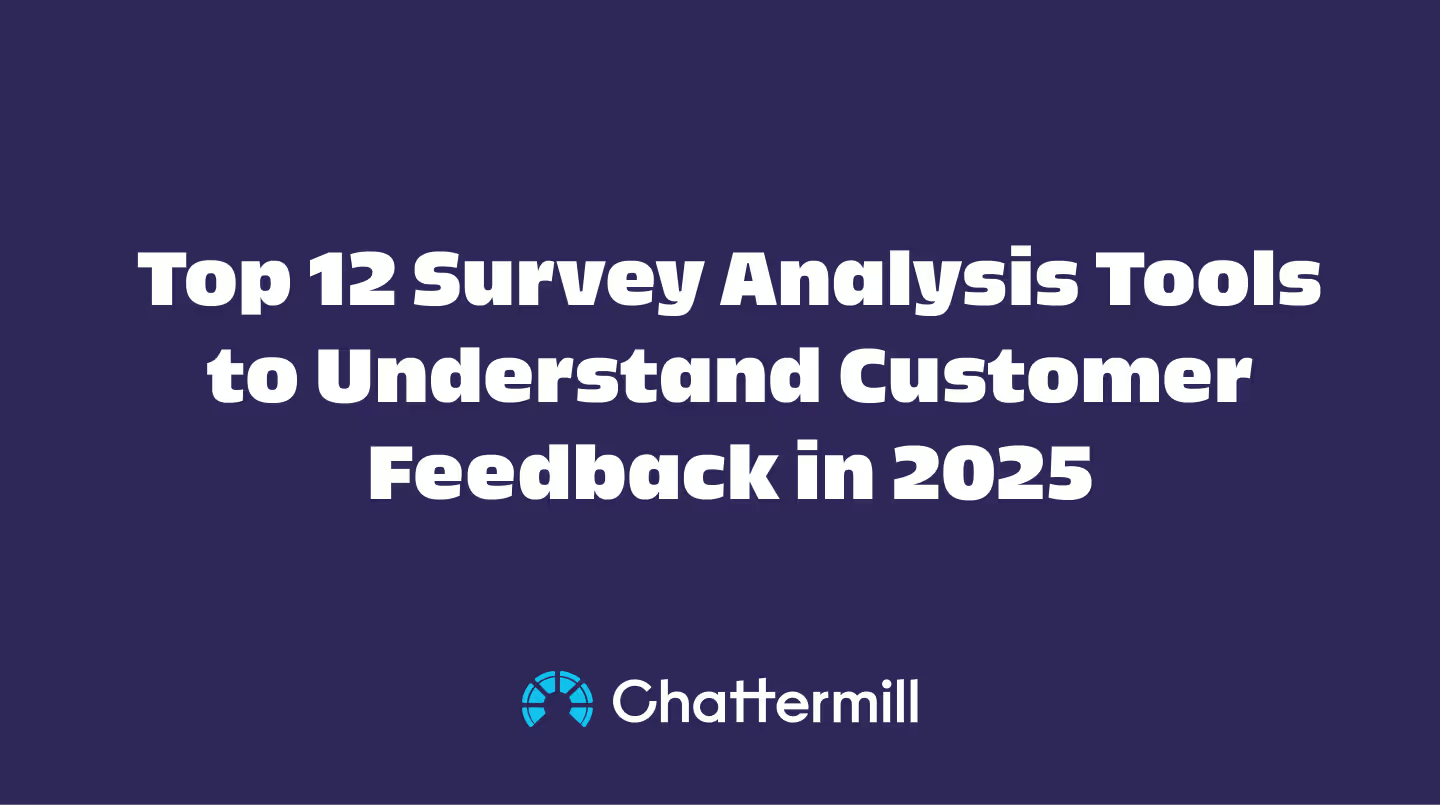Collecting survey responses is just the first step. The real challenge is analyzing that feedback and turning it into clear, actionable insights. Survey analysis software helps teams understand open-ended responses, identify customer sentiment, and uncover hidden patterns in large volumes of feedback.
With so many options available, choosing the right tool can feel overwhelming. Some platforms focus on surface-level reporting, while others offer powerful AI and natural language processing to dig deep into what your customers are really saying.
To help you make an informed decision, we analyzed the most credible and high-ranking sources on survey analysis software. This article is based on insights from:
- The CX Lead – 20 Best Survey Analysis Software of 2025
- VWO – 7 Best Survey Analysis Software and Tools
- Zonka Feedback – 12 Best Survey Analysis Software
- Displayr – Survey Analysis Software Guide
- SentiSum – 11 Best Survey Analysis Tools
We compared each survey analysis tool across features, pricing, and suitability for different teams.
Whether you're managing customer experience, running product surveys, or leading market research, this guide will help you choose the right software for your needs.
Free and Budget-Friendly Options (under $50/month)
These tools are well-suited for early-stage teams or those with limited survey volumes. They offer essential capabilities like survey building, basic feedback analytics, and light reporting. While not built for deep AI-powered insight, they provide valuable entry points into customer feedback workflows.
1. SurveySparrow
Starting at $19/month (free plan available)
What makes this tool great:
SurveySparrow focuses on engaging user experiences, offering chat-style surveys that boost response rates across channels. Its visual dashboards and smooth interface make it easy for non-technical teams to analyze responses quickly.
- Omnichannel surveys with conversational UX
- Dashboards and basic sentiment tagging
- Integrations: Slack, HubSpot, Google Sheets
Best for: Small businesses or teams collecting feedback from multiple channels
Drawback:
Limited depth in qualitative analysis. SurveySparrow is not ideal for teams needing advanced text or sentiment analytics. More robust feedback tools are better suited for CX and VoC professionals managing large data sets.
2. Jotform + Report Builder
Free and paid plans starting at $34/month
What makes this tool great:
Jotform shines in survey customization. Its form builder is fast and intuitive, with drag-and-drop logic and real-time charts that simplify the feedback process. The Report Builder adds lightweight analytics for quick overviews.
- Drag-and-drop survey builder with analysis widgets
- Conditional logic and basic reporting tools
Best for: Teams who need form-building flexibility with light analytics
Drawback:
Jotform is a form builder first, analytics tool second. It's missing key capabilities like text clustering, emotion detection, or deeper integration with analytics platforms. Teams looking to scale their analysis will hit a ceiling quickly.
3. Survicate
Starts around $56/month (10-day trial available)
What makes this tool great:
Survicate offers impressive flexibility for its price, allowing businesses to run targeted surveys across web, email, and mobile. It adds feedback tagging and journey insights that make it more sophisticated than most tools in this tier.
- Website, email, and in-app surveys
- Tag-based analysis and user journey insights
- Integrations: Intercom, HubSpot, Amplitude
Best for: Product and CX teams needing feedback across the customer journey
Drawback:
Survicate offers breadth over depth. While its tagging and routing are strong, it lacks advanced AI or NLP for true qualitative insights. Larger CX teams may need to pair it with a more powerful analytics engine to get actionable results from open-text responses.
Mid-Tier Survey Analysis Tools ($50–$250 per month)
Mid-tier tools offer a strong balance of usability, advanced features, and integrations. These platforms are ideal for growing CX, product, or research teams that need deeper insight than budget tools provide but aren’t yet ready for enterprise-scale platforms.
4. Zonka Feedback
Starts at $49/month (billed annually)
What makes this tool great:
Zonka Feedback brings serious capabilities to the mid-tier. It includes AI-powered sentiment and emotion detection, role-specific dashboards, and omnichannel survey distribution. Its real-time feedback loop helps teams act quickly and improve customer experience in the moment.
- AI sentiment and emotion detection
- Multi-channel surveys and dashboards
- Integrations: Intercom, Salesforce, Slack, Zapier
Best for: Mid-sized CX or support teams needing insight-rich reporting
Drawback:
Some users note the platform can feel complex initially due to its flexibility. It also lacks the brand recognition and ecosystem depth of more established players, which may limit third-party tutorials and community support.
5. Displayr
Custom pricing based on users and usage level
What makes this tool great:
Displayr is a powerful choice for researchers and data-heavy teams. It handles crosstabs, regression analysis, driver analysis, and significance testing with ease. The platform supports detailed visualizations and automates statistical workflows.
- Deep quantitative and statistical analysis
- Automated reporting and dashboards
- Supports integration with SPSS, Excel, PowerPoint
Best for: Market researchers and analysts managing large survey datasets
Drawback:
Displayr is designed for analysts, not CX or product teams. It lacks AI for text analytics and doesn’t prioritize qualitative insights. Users focused on customer experience may find it too technical or narrowly focused.
6. Sogolytics
Starts near $99/month depending on plan
What makes this tool great:
Sogolytics (formerly SoGoSurvey) offers a powerful mix of survey design and analysis tools, including multilingual capabilities, advanced branching logic, and real-time reporting. It supports secure enterprise feedback workflows and strong compliance features.
- Advanced survey logic and data segmentation
- Real-time dashboards and crosstab reports
- Integrations: Salesforce, Microsoft Teams, Zapier
Best for: Teams needing structured surveys with compliance and multilingual support
Drawback:
Sogolytics excels in form building and structured data analysis but lacks deeper qualitative tools. While it supports open-text fields, it doesn’t offer sentiment or topic modeling at the same level as AI-first platforms like Chattermill or Thematic.
Enterprise Survey Analysis Tools ($250+/month or custom pricing)
These platforms are built for high-volume, multi-channel feedback environments. They’re ideal for enterprises that need AI-driven insights, advanced user permissions, multilingual capabilities, and deep integration across their tech stack.
7. SurveyMonkey Enterprise
From ~$30–$39 per user/month on business plans
What makes this tool great:
SurveyMonkey Enterprise brings familiarity and scalability to customer feedback programs. It adds advanced analytics, centralized admin controls, team collaboration, and benchmarking features beyond the basic free version.
- Enterprise-grade access controls and analytics
- AI-based sentiment tagging (limited scope)
- Integrations: Salesforce, Zendesk, Microsoft Teams
Best for: Companies already using SurveyMonkey at scale looking to centralize control and reporting
Drawback:
SurveyMonkey’s core analysis features remain relatively basic. Its sentiment analysis is surface-level compared to newer AI platforms, and open-text insight depth is limited. It works better as a survey distribution tool than a true analytics engine.
8. Thematic
Custom pricing (typically $1,000+ per month)
What makes this tool great:
Thematic is designed for deep text analytics at scale. Its AI extracts themes and trends from open-text responses and tracks changes over time. It’s tailored for large CX and VoC programs that need to distill high volumes of qualitative data.
- Theme extraction and trend analysis
- Dynamic dashboards and filtering
- Integrations: Zendesk, Medallia, Salesforce
Best for: Enterprise CX teams with large unstructured datasets needing actionable insights
Drawback:
Thematic’s strength is also its limit — it focuses almost exclusively on text feedback. It may require pairing with another platform for quantitative analysis or survey deployment. Its pricing is also prohibitive for smaller teams.
9. SentiSum
Starting around $2,000 per user/month
What makes this tool great:
SentiSum excels in root-cause analysis for customer feedback. It uses machine learning to automatically tag and cluster support tickets, surveys, and reviews, making it ideal for operational insights and support optimization.
- AI-driven tagging and root-cause analysis
- Multichannel feedback intake (surveys, support, reviews)
- Real-time dashboards with impact scoring
Best for: Support and CX operations teams needing structured, explainable insights
Drawback:
SentiSum’s focus is operational support analytics — not broad CX or product feedback. It lacks survey-building tools and is often used as a layer on top of helpdesk systems. Pricing is steep, even for enterprise budgets.
10. MAXQDA
Starts at ~$15/user/month (academic), ~$200+ for enterprise plans
What makes this tool great:
MAXQDA is built for qualitative researchers. It supports deep text coding, sentiment analysis, and mixed-method research workflows. Ideal for teams conducting interviews, open-ended surveys, or case studies across languages.
- Qualitative and mixed-method analysis
- Code systems, visualizations, and team collaboration
- Used widely in academic, social science, and UX research
Best for: Researchers needing full control over qualitative data structuring and coding
Drawback:
MAXQDA is not a plug-and-play solution. It requires training and research expertise. While powerful, it lacks real-time dashboards and integrations expected by CX or product teams.
11. Crunch.io
Enterprise-only pricing (quotes required)
What makes this tool great:
Crunch.io powers data exploration and advanced survey analysis. It’s built for researchers managing complex survey data, enabling quick segmentation, filtering, and export-ready visualizations.
- Drag-and-drop crosstabs and dashboard builder
- Real-time analytics for large datasets
- Integration-friendly with external databases
Best for: Market researchers and data science teams handling longitudinal or high-volume data
Drawback:
Crunch.io focuses on quantitative insights. It lacks AI text analytics and doesn’t serve as a collection tool. Best when paired with external survey or feedback platforms.
12. Chattermill
Enterprise pricing (custom plans based on usage and team size)
What makes this tool great:
Chattermill is built specifically to analyze open-ended customer feedback across surveys, support tickets, reviews, and more. Using advanced AI and natural language processing, it uncovers recurring themes, sentiment shifts, and emotional trends in qualitative data, all in real time and across multiple languages.
- Advanced NLP with emotion and sentiment detection
- Real-time dashboards for CX, VoC, and Product teams
- Integrates with Typeform, SurveyMonkey, Qualtrics, Zendesk, and more
Best for: Enterprise teams needing structured insights from high-volume qualitative feedback
Drawback:
Chattermill doesn’t offer built-in survey collection. It’s designed to work alongside existing feedback collection platforms. Teams needing a combined collection-and-analysis solution may prefer an integrated suite like Qualtrics or Zonka.
How Teams Use Chattermill for Survey Analysis
This tool is favored by teams who already collect feedback using external tools but need deeper insights:
- Surface recurring themes from thousands of open-text survey responses
- Track sentiment shifts and root causes over time
- Filter insights by customer segment or touchpoint, and easily share dashboards across teams
Related Chattermill Resources for Readers Evaluating Survey Tools
To help decision-makers explore further, here are content pieces matching their keyword intent and tool evaluation journey:
- 10 Things You Wish You Knew Before Choosing a Customer Feedback Analysis Tool – helps teams evaluate analytics tool fit, scalability, and integrations.
- How to Analyze Customer Feedback in Retail: Tools & Strategies – demonstrates real-world impact of analyzing survey feedback top-down
- Survey Data Analysis: How to Analyze Survey Results – covers best practices in transforming survey data into insights with structured methodology
- A Deep Dive into Surveys: Open‑Ended vs Closed‑Ended – emphasizes when to use qualitative vs quantitative questions
Chattermill does not offer survey creation. It’s better suited for teams who already gather feedback (e.g. via Typeform or Qualtrics) and need a powerful analysis tool.
For help understanding what to look for, refer to our guide “10 Things You Wish You Knew Before Choosing a Customer Feedback Analysis Tool.”
See Chattermill in Action
If you're already collecting customer feedback and want to understand what it really means — Chattermill is built for you.
Whether you're managing NPS programs, running product surveys, or surfacing insights for your CX team, Chattermill gives you the clarity that basic dashboards can't.
✅ Analyze thousands of open-text survey responses instantly
✅ Identify recurring themes, sentiment trends, and root causes
✅ Integrate seamlessly with your current tools like Typeform, Qualtrics, and Zendesk
Let our team show you how Chattermill fits into your survey and feedback workflows.















